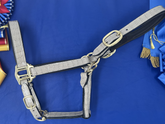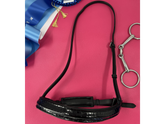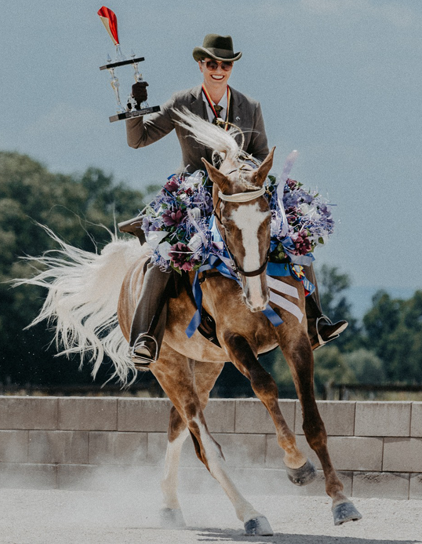WOW Saddles are Completely Modular
Welcome to Delfina Saddlery, home of WOW Saddles West Coast! Besides all the ground-breaking scientific breakthroughs WOW saddles offers, they're also the world's only modular saddle. Let's discuss what that means and the benefits it offers for you and your horse. As a leading provider of English tack and unique, handmade, custom leather accessories, we've seen our fair share of innovative (and not-so-innovative) designs in the equine industry, but the WOW's modular system is hands down the best saddle build we've ever seen.
Why you can trust us:
We are the only Authorized Wow Retailer and Certified Wow Saddle Fitters, serving California, Nevada, Oregon, and Arizona.
Our Owner is a lifelong horsewoman, with 39 years in the saddle and a degree in Equine Science from Virginia Intermont
We spent 23 years owning and operating our own hunter/jumper training facility; producing top Junior FEI riders, National Medal winners, and hundreds of Division Champions
Delfina Saddlery has been making and selling custom tack and leather accessories for horsemen and women for 12 years
Want to know more? Visit our store
Table of Contents
Conventional Saddle Construction
English Saddles
The earliest riding saddle can be physically traced back to around 500BC, and was found in a woman's burial plot in China. Some historians, however, argue that riding saddles were in use as early as 4000BC, again by the Chinese. Horses then were ridden bareback, until they began using a simple cloth with a tassel trim, attached to the horse using what we would call a girth, today.
The first solid, wood-treed saddle dates back to the Chinese terracotta army, in 206BC. This was a major improvement for equine welfare, finally enabling a rider to come closer to equally distributing their weight across a large area.
Fast forward to the early 17th century, and dragoon soldiers were riding in something very similar to the modern English saddle. Despite having a brass 'horn', the seat of the saddle was flat and minimal. There are front dee rings to hang a holster, and rear dees to hang a rolled cloak or valise. These saddles had two wool-flocked panels on the underside, against the horse, just as modern English saddles do.

Modern English saddles have remained largely unchanged since the 18th century, when foxhunting became a sport for the upper class. The style required a lighter, more forward cut to the saddle, which brought about something largely recognizable as the modern English saddle. Now, 300 years later, English riders are still sitting on what is essentially the same piece of equipment as foxhunters from 18th century England.

Here's a short, 5 minute video showing the process of making a traditional English saddle, courtesy of How It's Made.
Once the saddle's tree and seat have been formed and covered in leather, all the parts - the panels and flaps - are stitched and attached to the leather of the seat/tree. Your saddle is finally complete! But what if you get a new horse? Will that saddle fit him? Can that saddle be adjusted enough to accommodate a large difference in body shape between the two animals? Will you have to sell your old saddle and buy a new one that will fit? These are expensive questions - and they're vital to riding.
Western Saddles
Meanwhile, during the middle ages, the rise of regular people performing cow work and bullfighting forced saddles to evolve into a design with a higher cantle and pommel, offering added security to the rider. At this time, saddles also came largely in two models: the Moorish and the Hungarian. While the Moorish saddle evolved into the English saddle, the Hungarian evolved into the modern western saddle. Early Vaqueros saddles added a larger horn, to aid in roping cattle.

A western tree is typically crafted from wood. The seat is built up over the bars of the tree, suspending the rider between the cantle and swells. Skirts are hung from the tree, and one last thick piece of leather backed in fleece is attached under the tree, to help pad the area between the horse and the saddle. Western saddles do not feature panels filled with flocking like an English saddle, so it is even more crucial that the saddle fit the horse correctly.
In fitting western saddles, matching the shape of the bars to the shape of the horse is crucial due to this lack of 'panels'. Since the skirts and saddle pad are all - or should be - an even thickness throughout, they don't change the overall shape of the bars compared to the shape of the horse's back.

As you can see, not a lot has changed over the years; both the English and western tree is basically the same shape - perhaps construction materials have changed - and modern saddles still have all the same drawbacks to their design as the original version.
Replacing and Repairing Worn Parts

Until the early-2000's, most English saddles were made from thick, tough leather that could withstand the test of time. Many of us recall being passed down some Aunt's or family-friend's old English saddle as a treasured gift. My first English saddle had a maker's tag from the 60's - already 20 years old by the time I'd been gifted it - and that was considered young! Hard as a rock and slick as a river stone I still treasured it dearly. A few decades later, many big saddle brands began offering saddles with flaps and seats wrapped in calfskin - a 'stickier' leather that helped offer security and hold the leg still while riding. The saddles broke in much quicker and never got slicker with use. However - and this is important - we soon found out these saddles didn't last. Some riders began replacing their saddles every 2 - 3 years, which was unheard of up to that point. It turned out that while calfskin was lovely and sticky and soft and made from dreams, it was also delicate, and about as solid as a dream, and the method used to apply it lead to delamination of the layers, further hastening the breakdown of the leather. These saddles looked like unusable junk just a few years later. Having a saddler patch the flaps left you with large circles of odd leather on your flaps and, while not visible when riding, it stuck out like a sore thumb the rest of the time.
I recall my saddle tech once telling me not to bother repairing the tear in my seat, as the work would cost more than the saddle was worth. Instead, I used beeswax to fill the tear and bring the worn edges together, allowing me to extend the usable lifetime a few more years. While frustrating, that was my only option at the time.
God forbid something more serious happen - like this nice family of mice that made a new home in this rider's $6,000 CWD.
In cases like these, your only option is to toss the saddle and pay for a brand new one. Depending on your tastes, this could run anywhere from $2,000 - $12,000.

Further Reading
WOW's Modular Solution to Saddle Build
Unlike any other brand of saddle, WOW saddles are completely modular - right down to the dee rings.
When your Authorized Fitter makes an appointment to fit you and your horse for a new WOW, they'll use a special proprietary tool called a Saddle Gauge. While competitors have attempted to copy the WOW Saddle Gauge, when used by a Certified WOW Fitter, it stands alone in determining perfect, precise saddle fit for both horse and rider.
The Saddle Gauge tells your Fitter exactly what sizes of all the various parts you and your horse require. Once determined, your Fitter will order the correct panels, flaps, and seat (which covers the tree) for you and your horse. Prior to delivery, everything will be put together - including the blocks - so it's ready for you to just jump on.
Should you ever need to have your flap or seat repaired or replaced, a single tool is all you need to disassemble the entire saddle.
If you need a replacement part, WOW's modular build means you can order only what you need. Did a mouse nest in your seat? Just buy a new one and attach your old panels and flaps to it. If a dee ring tears off, just attach a new one - by yourself, if you're so inclined!

Please note: Due to the extremely complex build and breadth of options available, it is absolutely not possible to “eyeball” a horse for a WOW saddle. Only a Certified WOW Fitter should fit your horse, and, failing that, use of the WOW saddle gauge to determine your horse's optimum saddle fit is absolutely required. If you do not live in California, Oregon, Nevada or Arizona, or you do not have a Certified WOW Fitter in your state, Delfina Saddlery offers video consultations, assisting you in proper use of the WOW saddle gauge to fit your horse for a WOW saddle.
Please contact Delfina Saddlery if you have any questions about you or your horse's WOW Saddle needs, or if you would like to schedule a 110-Point Horse & Rider Fitting Assessment.
Delfina Saddlery is the only Authorized and Certified WOW Saddle Fitter in California, Oregon, Nevada, and Arizona.

If you're into experimental designs, flapless saddles have been shown to improve rider security in the saddle. With a WOW, you can easily remove the flaps of your saddle and not lose any other important parts (like your stirrups!), then add them back when you're done. There's no need to spend $5,000 on a practice Butet just to experience a flapless saddle.
Or, perhaps you ride two disciplines - simply purchase a set of dressage flaps and a set of jumping flaps and change them out as you go. You no longer need to purchase two expensive saddles when you own a modular WOW.
Another bonus of the modular system employed by WOW saddles is the easy addition and removal of accessory parts. For example, if your horse requires a foregirth, it will take just one tool to take the saddle apart, install the foregirth, and reassemble it.
Ocassionally a horse will require a specific setup, like a foregirth, on a temporary basis. Young horses, horses coming back from rehab, and horses slowing down as they enter their golden years often experience radical conformational changes as their fitness levels adjust. Owning a WOW Saddle means your saddle will always be able to adjust and adapt to any change your horse throws at it. There will no longer be any need to go saddle shopping yet again because your young horse finally grew his withers or your older horse has lost some of his topline.
It really is that easy!

Replacing & Repairing Worn WOW Parts
When a part has worn out and requires repair, the individual part can be sent back to WOW HQ for work. This means spending less on shipping costs, and may even mean you can continue riding until receiving the part back (as in the case of a flap). If the part needs total replacement, simply order the part from WOW, wait for it to arrive, and install yourself (or you're always welcome to call or text Delfina Saddlery at (310) 817-6910 to install the new part).
Everything from the panels to the dee rings is completely modular on a WOW.
Not only are the parts interchangeable, if you're using one of WOW's two Flair Air Flocking Systems, even the internal parts of your panels are modular, too, allowing you to quickly and easily replace a broken or aging Flair air bag or replace an aging or deteriorated piece of the surrounding foam. You no longer need to purchase a whole new saddle - or even a whole new panel - due to old flocking!
What if you buy a new horse?
Just like the seat and flaps of a WOW saddle, the panels are interchangeable, meaning you can easily remove existing panels using a single screwdriver on 3 individual bolts per panel. This allows you to easily change the panels of your WOW saddle when you buy a new horse, your horse changes shape, a part needs replacement or service, or you want to use your saddle on a different horse entirely.

Backwards Compatibility
WOW is infamous in Europe for thinking of every last detail, and backwards compatibility is one of them. Almost all parts are compatible on older WOW saddles; at most, you may need a different attachment bolt. All parts are compatible across disciplines and model lines, too, meaning you can upgrade your Classique's foam panels to improved Flair panels if you're so inclined. Even the western saddle's headplates can be used on an English saddle tree in a pinch (though a portion of it will stick out the front).
Conclusion
English saddles have been in use for hundreds of years but have remained largely unchanged since their invention. That’s left the modern horse facing all the same problems horses faced hundreds of years ago, with no hope for salvation. The result has been chronic soft-tissue injuries, sore backs, and front-end lameness due to ill-fitting saddles that just don't work. It wasn't until WOW Saddles looked at the most common problems facing modern saddles that a solution was found, and WOW's modular design is a large part of that solution.
Professional trainers, Olympic riders, and thousands of riders around the world use WOW saddles across disciplines because they know a WOW saddle is the best saddle you can put on your horse. You can trust their testimonials because WOW will never, and has never, paid for a rider or trainer to use any of their products nor sponsored a rider or trainer or given them free products to endorse the brand.
Fans of WOW love their saddles because their horse loves their saddle and they love their horse.
"The best saddle I've ever ridden in!"
Richard Davison - Four Time Olympic Dressage Rider, British Dressage World Class Equestrian Programme Performance Manager and British Olympic Dressage Team Captain











Leave a comment
Please note, comments need to be approved before they are published.